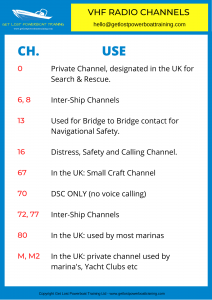VHF Radio Channels
Different VHF Radio Channels have different uses. Some we can access on our marine VHF radio sets and some we cannot.
An example of a channel that we can’t access is Channel 0 or Zero. This channel is reserved for Search And Rescue (SAR) services and as such the public can’t access or interfere with it.
Channel 16
One of the most important channels to us is Channel 16. This channel is known as the Distress, Safety & Calling channel. When you are underway in your the VHF radio should be set to Channel 16 so that you can monitor it. On this channel you will hear messages related to it’s designation. For example:
- Distress calls will be made on this channel and administered by the Coastguard
- Safety messages (known as Securite messages) will be broadcast on this channel. These may include navigational warnings and weather updates.
- If somebody wants to call you, they will do so on channel 16. This is because it’s the channel we all monitor.
Other Useful Channels
There are four channels for routine communications. These are known as the working channels. They are 6, 8, 72 and 77. Routine calls are covered later in this course.
Channel 13 is used to call from one ship to another to discuss matter of navigational safety. This is known as the Bridge to Bridge channel.
Channel 70 is an interesting channel as we can’t talk on it. There is a system built into our VHF radios that is called DSC. This stands for Digital Selective Calling and is a bit like a text message service for the radio network. You will learn how to use this during your VHF radio course. Channel 70 is reserved for these digital transmissions.
In the UK Channel 80 is typically used by marinas. When you are calling up to see if they have a berth available or to find out what facilities they have, you use this channel.

